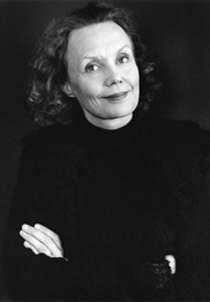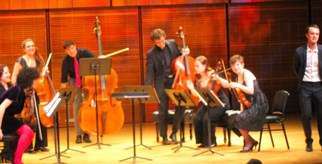|
Back
A Nonet of Young Sounds New York
Zankel Hall, Carnegie Hall
03/12/2012 -
Kaija Saariaho: Folia (New York Premiere) – Cloud Trio (United States Premiere) – Aure (United States Premiere)
Louis Chiappetta:Loops, Clocks and Shadow
Jenny Beck: The Tide will Take You
Chris Williams: San-shih-Fan
Ursula Kwong-Brown: Adunamentum
Anna Pidgorna: The Child, Bringer of Light
Edmund Finnis: Relative Colour (All the foregoing are World Premieres, commissioned by Carnegie Hall)
Young Artists Performers: Aisha Orazbayeva, Sarah Saviet (Violins), Emily Deans, Anna Pelezer (Violas), Paul Dwyer, Mira Luxion (Cellso), Tony Flynt (Bass), Edmund Finnis (Conductor), Kaija Saariaho, Anssi Karttunen (Directors)

K. Saariaho (© Ralph Mecke)
A second evening highlighting Kaija Saariaho, as leader, judge and honoree of this year’s Richard and Barbara Debs Composer’s Chair at Carnegie Hall, asks the question: “When does this most prolific composer have time to compose??”
Just as one cannot picture Franz Liszt jotting down his music in between salons, concerts, essays and affaires de la cour, so Ms. Saariaho has given of her time, presented new and old works, and offered opportunities (as she did last night) for other composers to show their very accomplished music, played by most accomplished international musicians.
Those composers, though, had a special challenge, precluding a lack of inspiration with brass fanfares, new woodwind techniques, booming drums or piles or dazzling orchestral colors. They were confined to solo strings in diverse combinations. Whatever weaknesses or strengths they had were blatantly put on trial in Zankel Hall.
Of course Ms. Saariaho who premiered one work with the St. Louis Orchestra last Saturday and had a whole evening of her chamber music last Friday, did not shirk to have her own work placed among the youngsters. And truth be told, it needed no gimmicks for music that was feeling, mysterious and very touching.
Most wonderful of all was Aure for violin and viola, based on a theme–no, not a theme, but three simple notes–from Henri Dutilleux’ Shadows of Time.
Very simple notes they are too: one note, a half-note up, and a third up from there. Yet what Ms Saariaho does with this music!. She doesn’t transform it, doesn’t deconstruct it, but repeats it over and over again in different entangling forms of the instruments. The very simplicity becomes, not more complex, but more radiant and glowing as we hear it repeated by the instruments.
(This was in contrast fo Chris Williams’ San-Shih-Fan which more or less deconstructed one chord from the Chinese zither. It was deft, dense, and cold.)
Ms. Saariaho’s longest work was Cloud Trio, a four movement piece for two string trios, each with a separate movement. She challenged us to “guess” the type of cloud she had seen the French Alps one day, but trying to put a non-Debussyan Nuage picture to the four engaging movements was only distracting.

T. Flynt (© Coco T. Dawg)
One work which I loved absolutely was Folia for solo double bass–played with unbelievable fingerwork by Tony Flint–along with electronic enhancement. The sounds, I would guess, were not recorded separately, but echoes of his own music: pitch modulations, overtones and harmonics, and a thickening of his own textures.
In other words, a labyrinth of mysterious lights and darks. And while I know that Ms. Saariaho lives in France, I remembered a week I spent under the midnight sun in Roveniemi, Finland’s northern capital, with its own strange effects.
The other works were highly interesting. Jenny Beck’s The Tide Will Take You was also imagic, in this case the imagery of water, for violin, viola and cello. Ms. Beck was not afraid to use crescendos for painting a great tidal wave (maybe...at least that was my picture), or of showing the suspension and tension of waters.
On the other hand, we had Louis Chiappetta’s Loops, Clocks and Shadows, a work of sheer deconstruction based on the Bachian mathematics of Douglas Hofstander’s massive work. It was cleverly assembled, obviously of great mathematical import, but the statement would be for the textbooks, for the analysis. Hearing it for the first time, even understanding to a degree, the fungible repetitions, I was not moved.
The most “romantic” piece was unexpected. Ursula Kwong-Brown’s Adunamentum, a medieval Latin word meaning both harmony and atonement. Unlike any other work on the program, it actually had passion, a passion reminiscent of the Transfigured Night sexual emotions of Schoenberg. But its two movements brought a whirling giddiness.
Anna Pidgorna’s The Child, Bringer of Light, for solo cello, was played wonderfully by Paul Dryer, and was indeed a “story” of birth and enlightenment

E. Finnis (Right) with ensemble (© Coco T. Dawg)
The only piece needing a conductor was the final one, Edmund Finnis’s Relative Colour, for all seven soloists. Amongst many of Mr. Finnis’s accomplishments is writing music for art galleries, and his explanation here is based not only on Bridget Riley’s “vibrant paintings” but how “adjacent colours seem to vibrate against each other”.
To demonstrate this and similar aesthetic theories, Mr. Finnis “detunes” the strings at one point (I’m uncertain of the meaning), plays one trio against another, underpins the music with a double bass, and “vibrates” one tone color against another.
Like the rest of the program, this was an ambitious challenge, and so complex that I would love to hear the work again. But confessedly, after more than two hours of premieres, one’s mind can drift, even long for a few bars of the familiar. Ms. Saariaho and her partner in this program, cellist Anssi Karttunen, discovered many a new world. But the outside, our own New York, was equally comforting.
Harry Rolnick
|